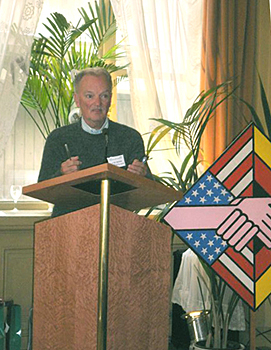
McNabb, now program coordinator for UD's Center for International Studies, recently included his memories of that event in a presentation in Heidelberg, Germany, at a convention celebrating the 60th anniversary of the founding of the Federation of German-American Clubs and the 50th anniversary of the student exchange program.
“I arrived in Würzburg [located in the northern part of Bavaria, about 300 miles southwest of Berlin] in July 1961, and construction of the wall began in mid-August,” McNabb said. “We were sitting in the kitchen of Internationales Haus (a student residence) when a radio report came on about the construction of a wall soon to be built by the East German authorities to divide the city of Berlin.”
As summer progressed, the purpose of the wall became clear to the German and American students living in Würzburg, McNabb said.
“With the building of the Berlin Wall came the realization that some of our students from East Germany might not be able to see their families again,” McNabb said. “Anger also began to sink in about the ridiculousness of the whole thing. I also remember watching a news report of the wall coming down in 1989.”
While the Berlin Wall is long gone, McNabb noted that the Federation of German-American Clubs and the student exchange program it sponsors both continue to grow and to fulfill the vision and goals of the founders.
Since 1957, the Federation of German-American Clubs has been sending American high school and college students from throughout the United States to study in Germany, while their German counterparts visit and attend schools in the U.S.
“The Federation started in 1947, when U.S. Gen. Lucius D. Clay, the commander of the U.S. Armed Forces in Germany, decided to do something to improve U.S.-German Relations,” McNabb said. “The University of Delaware signed on in 1961 and continued the affiliation by sending one student to Germany and receiving one student each year, until 1969, when the number of UD/Federation scholarships was increased to two annually, a number that continues until the present time.”
Clay was military governor in the American Zone in Germany from 1947-49, where he worked with British and French allies to organize the Berlin Airlift in 1948 to provide the inhabitants of West Berlin with food, coal and other supplies when the Russians attempted to seal off the city from all contacts with the West.
As UD administrator of the Federation of German-American Clubs student exchange program, McNabb said that participation in the program is open to students of all majors, and that courses taken in Germany may count towards a student's overall UD graduation requirements.
American students may request to be placed at any of the participating German universities or technical high schools in Bamberg, Berlin, Bielefeld, Darmstadt, Duisburg, Düsseldorf, Erfurt, Erlangen-Nürnberg, Essen, Frankfurt, Giessen, Hamburg, Heildelberg, Kaiserslautern, Karlsruhe, Kassel, Mainz, Mannheim, Munich, Stuttgart, Tübingen or Würzburg.
The one basic perquisite for participation in the program is a good working knowledge of the German language, as all course work is the language of the host country. Information and application materials are available at the Center for International Studies, McNabb said.
“We encourage students to take courses in Germany that they would not get a chance to take at UD,” McNabb said. “It's also helpful for participants to have a high level of intellectual curiosity and an adventuresome spirit.”
McNabb, who received the annual Student Exchange Award from the Federation of German-American Clubs at its annual conference held in Erfurt, Germany, in 2001, for his efforts promoting the exchange of students between the two countries, said that all of Germany, including the eastern part, has grown considerably since those lean times of the post-World War II period recovery and Cold War confrontations.
Since the federation's inception in 1957, when Oberlin College in Ohio became the first American college to establish a partnership, more than 2,000 college students (plus hundreds of high school students) have participated in the German-American Club's student exchange program, McNabb said. States represented by participating institutions include Alabama, Arizona, Florida, Georgia, Michigan, Minnesota, New Hampshire, New York, Ohio, Tennessee, Texas, Vermont and Washington.
“Students have come to view this program as a life-changing event, and they often make return visits to their host families,” McNabb said. “I, for example, have made many wonderful friends, and some of the students I met during my Würzburg year are still in touch with me.”
Article by Jerry Rhodes


